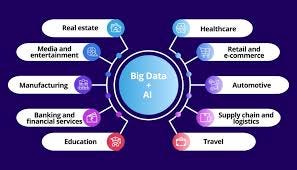Beyond AI and Big Data: What’s Next for Data Science?
- Get link
- X
- Other Apps
Introduction
Data science has been synonymous with AI, Big Data, and machine learning for years. However, as technology evolves, the landscape of data science is shifting beyond these core areas. The next wave of innovation promises breakthroughs that will redefine industries, enhance decision-making, and unlock new opportunities.
So, what’s next for data science? Let’s explore the emerging trends shaping its future.
1. Edge Computing and Real-Time Analytics
With the explosion of IoT devices and the need for instant decision-making, edge computing is transforming how data is processed. Instead of relying on centralized cloud servers, data is analyzed at the source (on the device or local servers), leading to lower latency, faster insights, and reduced bandwidth usage.

Key Benefits:
- Faster data processing at the edge
- Improved real-time analytics for industries like healthcare, finance, and autonomous vehicles
- Enhanced security by keeping data local
2. Quantum Computing’s Role in Data Science
Quantum computing, though in its early stages, holds the potential to revolutionize data science. Quantum algorithms can solve problems in seconds that would take traditional computers years, impacting fields like cryptography, optimization, and complex simulations.

How it Impacts Data Science:
- Faster data processing for large-scale computations
- Breakthroughs in predictive modeling and deep learning
- Improved security with quantum encryption
3. Data-Centric AI: The Shift from Model-Centric AI
Traditional AI development focuses on improving algorithms, but data-centric AI emphasizes refining and enhancing data quality. High-quality, well-labeled datasets are becoming more valuable than complex models.

Key Takeaways:
- Better AI performance with cleaner, more structured data
- Reduced bias and improved accuracy in AI models
- Enhanced automation in data preprocessing and labeling
4. Explainable AI (XAI) for Ethical Decision-Making
As AI continues to integrate into critical applications like healthcare, finance, and law, the demand for explainable AI (XAI) is growing. XAI ensures that AI-driven decisions are transparent, interpretable, and free from hidden biases.
Why It Matters:
- Builds trust in AI-based decision-making
- Improves compliance with data regulations (e.g., GDPR, CCPA)
- Reduces risks in high-stakes applications like autonomous systems
5. AI-Augmented Data Science
AI itself is revolutionizing data science workflows. Automated Machine Learning (AutoML) tools and AI-powered analytics platforms are making data science more accessible, even for non-technical users.
Impacts on Data Science:
- Automating repetitive tasks (data cleaning, feature engineering, model selection)
- Faster insights with AI-assisted analytics
- Democratization of data science with no-code/low-code tools
6. Sustainable and Green Data Science
With data centers consuming massive amounts of energy, sustainable data practices are gaining traction. Companies are focusing on energy-efficient algorithms, optimized cloud storage, and eco-friendly AI models to minimize carbon footprints.

Future Outlook:
- Carbon-aware computing strategies
- Optimization of cloud resources for sustainability
- Eco-friendly AI models that use fewer computing resources
FAQs: Answering Common Questions
Q1: Will data science jobs be replaced by AI? AI will automate certain aspects of data science, but human expertise in interpreting results, strategy, and domain-specific knowledge will always be required.
Q2: Is quantum computing practical for data science today? Quantum computing is still in its infancy, but advancements in the next decade could make it a game-changer for specific high-computation tasks.
Q3: How can businesses prepare for the future of data science? Businesses should invest in edge computing, ethical AI, and data-centric strategies while staying updated with emerging technologies.
Q4: What’s the most in-demand data science skill for the future? Skills in cloud computing, AI ethics, explainable AI, and automation (AutoML, no-code AI) will be highly valuable.
Conclusion
The future of data science extends beyond traditional AI and Big Data. With advancements in edge computing, quantum computing, explainable AI, and sustainable practices, the industry is evolving toward more efficient, transparent, and ethical solutions.
Want to stay ahead in the world of data science? Learn the latest skills with expert-led courses at Naresh IT and future-proof your career!
- Get link
- X
- Other Apps

Comments
Post a Comment